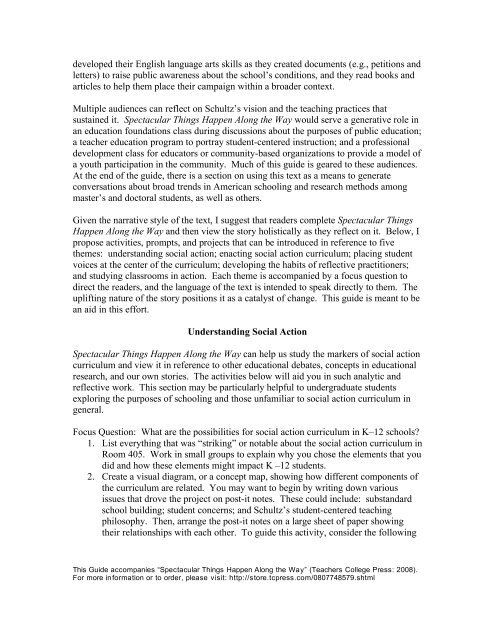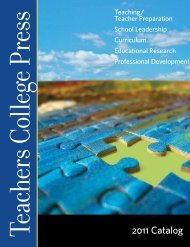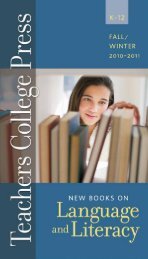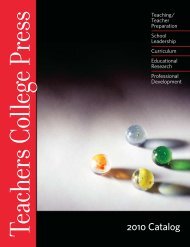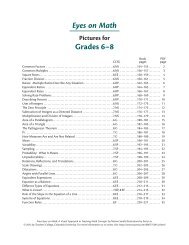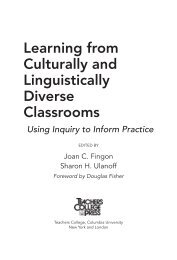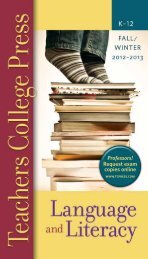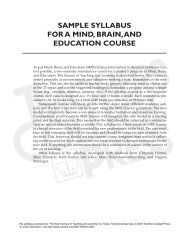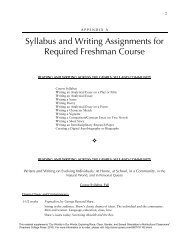Spectacular Things Happen Along the Way - Teachers College Press
Spectacular Things Happen Along the Way - Teachers College Press
Spectacular Things Happen Along the Way - Teachers College Press
Create successful ePaper yourself
Turn your PDF publications into a flip-book with our unique Google optimized e-Paper software.
developed <strong>the</strong>ir English language arts skills as <strong>the</strong>y created documents (e.g., petitions and<br />
letters) to raise public awareness about <strong>the</strong> school’s conditions, and <strong>the</strong>y read books and<br />
articles to help <strong>the</strong>m place <strong>the</strong>ir campaign within a broader context.<br />
Multiple audiences can reflect on Schultz’s vision and <strong>the</strong> teaching practices that<br />
sustained it. <strong>Spectacular</strong> <strong>Things</strong> <strong>Happen</strong> <strong>Along</strong> <strong>the</strong> <strong>Way</strong> would serve a generative role in<br />
an education foundations class during discussions about <strong>the</strong> purposes of public education;<br />
a teacher education program to portray student-centered instruction; and a professional<br />
development class for educators or community-based organizations to provide a model of<br />
a youth participation in <strong>the</strong> community. Much of this guide is geared to <strong>the</strong>se audiences.<br />
At <strong>the</strong> end of <strong>the</strong> guide, <strong>the</strong>re is a section on using this text as a means to generate<br />
conversations about broad trends in American schooling and research methods among<br />
master’s and doctoral students, as well as o<strong>the</strong>rs.<br />
Given <strong>the</strong> narrative style of <strong>the</strong> text, I suggest that readers complete <strong>Spectacular</strong> <strong>Things</strong><br />
<strong>Happen</strong> <strong>Along</strong> <strong>the</strong> <strong>Way</strong> and <strong>the</strong>n view <strong>the</strong> story holistically as <strong>the</strong>y reflect on it. Below, I<br />
propose activities, prompts, and projects that can be introduced in reference to five<br />
<strong>the</strong>mes: understanding social action; enacting social action curriculum; placing student<br />
voices at <strong>the</strong> center of <strong>the</strong> curriculum; developing <strong>the</strong> habits of reflective practitioners;<br />
and studying classrooms in action. Each <strong>the</strong>me is accompanied by a focus question to<br />
direct <strong>the</strong> readers, and <strong>the</strong> language of <strong>the</strong> text is intended to speak directly to <strong>the</strong>m. The<br />
uplifting nature of <strong>the</strong> story positions it as a catalyst of change. This guide is meant to be<br />
an aid in this effort.<br />
Understanding Social Action<br />
<strong>Spectacular</strong> <strong>Things</strong> <strong>Happen</strong> <strong>Along</strong> <strong>the</strong> <strong>Way</strong> can help us study <strong>the</strong> markers of social action<br />
curriculum and view it in reference to o<strong>the</strong>r educational debates, concepts in educational<br />
research, and our own stories. The activities below will aid you in such analytic and<br />
reflective work. This section may be particularly helpful to undergraduate students<br />
exploring <strong>the</strong> purposes of schooling and those unfamiliar to social action curriculum in<br />
general.<br />
Focus Question: What are <strong>the</strong> possibilities for social action curriculum in K–12 schools?<br />
1. List everything that was “striking” or notable about <strong>the</strong> social action curriculum in<br />
Room 405. Work in small groups to explain why you chose <strong>the</strong> elements that you<br />
did and how <strong>the</strong>se elements might impact K –12 students.<br />
2. Create a visual diagram, or a concept map, showing how different components of<br />
<strong>the</strong> curriculum are related. You may want to begin by writing down various<br />
issues that drove <strong>the</strong> project on post-it notes. These could include: substandard<br />
school building; student concerns; and Schultz’s student-centered teaching<br />
philosophy. Then, arrange <strong>the</strong> post-it notes on a large sheet of paper showing<br />
<strong>the</strong>ir relationships with each o<strong>the</strong>r. To guide this activity, consider <strong>the</strong> following<br />
This Guide accompanies “<strong>Spectacular</strong> <strong>Things</strong> <strong>Happen</strong> <strong>Along</strong> <strong>the</strong> <strong>Way</strong>” (<strong>Teachers</strong> <strong>College</strong> <strong>Press</strong>: 2008).<br />
For more information or to order, please visit: http://store.tcpress.com/0807748579.shtml


